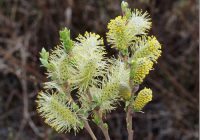Dr Phil Smith’s Wildlife Notes
March 2017
In contrast to the previous six dry months, March had average rainfall with measurable amounts on 12 days, most notably on 22nd when several hours of steady rain was something we haven’t experienced here for over a year. Despite this, there was minimal recharge of the water-table, my measuring point at the Devil’s Hole dune-slack being still 5cm below ground by the end of the month. Breeding by Common Toads, Common Frogs and Smooth Newts was therefore restricted to the deeper wetlands on the coast. Common Toads were active at Cabin Hill on 4th, when about 100 batches of frog spawn had already been laid in the main scrape. Later, I counted 50 dead Common Toads at this site, only four of which had been predated. I have seen mass mortality of this species here before but those corpses had been partially eaten. This time, the cause of death remains a mystery. The Lifeboat Road Natterjack scrapes were almost dry but it was good to see many immature Smooth Newts under pieces of wood, reflecting last year’s better breeding conditions.
A bird-watching trip to Marshside on 2nd produced 23 Little Egrets on the saltmarsh and three Mediterranean Gulls in front of the main hide. Even better were two Water Pipits which I was able to view from Ron Jackson’s Land Rover parked on the coast road embankment. Breeding in the mountains of central and southern Europe, the Water Pipit is a scarce winter visitor to our shores. One of the most reliable places to see this bird in “Lancashire” has been Warton Bank on the north side of the Ribble. Latterly, however, small numbers have occurred most springs on the saltings opposite Crossens Sewage Works. They are usually accompanied by Meadow Pipits and Pied Wagtails but this time there was also a smart Grey Wagtail. As usual, Avocet numbers gradually increased at Marshside during the month, my largest count being 64 on 13th. The first Wheatears were reported locally around 18th but I had to wait until 28th to see two perky males and a female on the Southport Marine Lake dunes.
During March, my garden was dominated by a resplendent male Pheasant. It turned up out of the blue and took up residence, eating me out of house and home, even pecking my lounge window, as if to say “Please sir, I want some more”. To cap it all, he then brought along a girl-friend, frequent noisy displays to her sometimes waking me up at 7.00am!
One of this month’s highlights is the emergence of Vernal Mining Bees; these honey-bee-sized solitary bees are often abundant on south-facing dune slopes with bare sand for their tunnels. On 25th, I estimated as many as 1170 flying on the Hightown sand ridges that were created near the Sailing Club after sea-defence works in 2011. A Red Data Book species, once confined to Northwest England and North Wales, this entertaining insect is now invading southern England from Europe.
Also unmissable in March is the flowering of the nationally rare Early Sand-grass on the dunes west of Southport Marine Lake. Patricia Lockwood and I went to see it on 23rd, returning a few days later with members of The Biodiverse Society group who are surveying the flora and fauna Marine Lake and its surrounds this year. As well as an abundance of this tiny grass we recorded a range of other spring annuals, such as Sea Mouse-ear, Little Mouse-ear, Hairy Bitter-cress and Lesser Chickweed. Nearby, but not yet flowering, were four plants of Isle of Man Cabbage, another speciality of this site. Completely unexpected, however, was a colony of Winter Stalk-ball, an uncommon fungus not seen here before.
Walking down Range Lane on 21st past golden blooms of Lesser Celandine, I was delighted to find the first bright-red catkins of the native Black Poplar. Continuing on to the Devil’s Hole, it was even more gratifying to note large catkins on the rare hybrid willow Salix × friesiana. Although there are over 100 bushes here, they were previously too young to flower.
My developing interest in mosses and liverworts led to several bryophyte safaris with Joshua Styles, Cabin Hill National Nature Reserve (NNR) being one of our targets as there is no list for this site. We soon found about 30 kinds, several being restricted to the bark of an old Crack Willow. They included a strange purplish liverwort, the Dilated Scalewort and Elegant Bristle-moss, a new species for the Sefton Coast,. Another successful trip was to the pinewoods of Ainsdale Sand Dunes NNR. I am not a great fan of conifer plantations but the damp, acidic conditions and partial shade is ideal for a rich variety of bryophytes. Small slacks surrounded by trees produced a stunning red Sphagnum which Josh keyed out to Acute-leaved Bog-moss, previously thought to be extinct here. It was growing with Bog Beard-moss and an unknown liverwort that was eventually identified by John Lowell, the county recorder, as Common Pawwort. This is mostly found in mountains and is also new to the Sefton Coast.




